Bicycle improvements

Who normally likes cycling and moves by bicycle, gets 30 kilometers per hour quite easily. If you travel down the slope or with the wind behind, you can reach a speed of up to 40 kilometers per hour and, for a moment, you can reach 50 km/h to the sprint. However, the Indurain rider from Navarre has reached average speeds above 52 km/h in stages of around 60 km time trial, and has left the squad at full speed at 50 km/h in goal with good riders at 70 km/h.
These speeds here expressed ten years ago were a dream that the bike itself has had much to do in making reality. Between the cyclist and the road there is a machine with its wheels, frames, saddle and handlebar. The problem is to adapt the machine to the characteristics of the cyclist to make the most of his effort.
Adapting the machine to the person
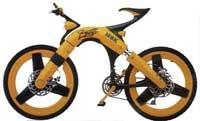
The drive power of the machine, the cyclist seems to alternatively push two pedals down. It is intended to convert the upward and downward movement of the foot into rotary motion, with a performance preferably of 100%. And there the obstacles begin. Because the leg is not a straight connecting rod with an upper and lower axis. It is a set of levers with its main joints in hip, knee and ankle.
Transmitting all energy to the pedal without wasting anything through this set of levers is no easy task, and so far improvements have been empirically achieved in this field. The biomechanical Armel Andre began to deal with this problem about twelve years ago. From the morphological, physiological and psychological point of view, he began to design an ideal bicycle for each cyclist.

It is essential to correctly calculate the triangle between the rider's three contact points (pedal, saddle and handlebar). Consider the person's center of gravity and the most appropriate way to exercise strength. To do this you have to take all the measures to the cyclist: length of the back, bern, thigh, arm, etc. Other measures on the fixed bike include wheel power, heart rate, oxygen consumption, calorie expenditure and muscle strength.
When treating all this data with the computer, the measurements of the frame will be extracted to optimize the physiological and mechanical performance. The tailor-made bike for each single rider is an average performance of 20%. On the other hand, for cyclists who travel 45 km/h in races, the improvement is around 8-9%.
Improving aerodynamics
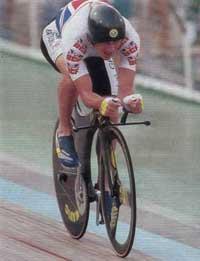
Once the best frame is chosen for each person, the rider's energy expenditure will be minimized to the maximum. He is a cyclist who tires against the air. To realize this there is nothing more to see how difficult it is to cycle when the wind is contrary.
With the rider standing on the bike the wind resistance is measured, but if you move on the machine the resistance measures change quickly. However, the figures for the rider standing on the bike are significant. 50 km/h requires a power of 500 or 600 watts and 60 km/h (in spring per kilometer on track) a power of 700 watts. When the arrival moves through the platoon and heads at 70 km/h, at some times it needs 850 or 900 watts.
As indicated, the aerodynamic resistance at 50 km/h requires a power of 600 watts. Of these, 400 are endurance offered by the rider himself and the remaining 200 bikes (conventional and not track). The descent of these 400 watts is very difficult, since the cyclist goes with his head down and the change of posture would mean a lower physiological performance. However, you can try to lower the 200 watts corresponding to the machine. The formation of turbulence in the frame, pedals and wheels makes the air resistance high. All frames, handlebars, wheels, brakes and elements are therefore analyzed.
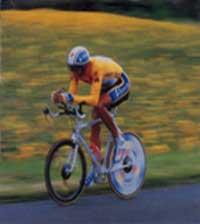
The conventional bike frame is usually cylindrical tube, but the cylinder is not aerodynamically suitable. Aerodynamically the ideal is the shape of the raindrop or wing of the plane, if the air blows from the front, but on the bike often the air is also lateral. Therefore, the shape between the wing of the plane and the cylinder has been sought, whether the wind blows from front or side. The ideal profile is elliptical for the frame, but for the steering tube and fork arms the raindrop profile is left.
The handlebar has also changed a lot for the time trial stages of the road. Two bars are placed stretched forward to support the arms, as the cyclist Lemond used them on the 1989 Vuelta a Francia. Recent studies have shown that these handlebars produce obstacles in the rider's breathing, but the damage in this area is lower than the aerodynamic benefits. However, the molded assembly of the flight flap profile has recently emerged to support the arms, to replace the traditional handlebar and the two bars.
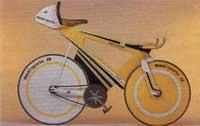
With the improvement of the frame profile and handlebars, you earn dozens of watts of air resistance, or what is the same, the cyclist goes to a km/h or faster by the same power. However, the aerodynamics of the wheels have also made progress. About seven years ago the full wheels appeared without radii (in the form of lentils), with which also come down in resistance tens of watts when the wind blows before, if we compare it with the radio wheels.
But when the wind is lateral, they are harmful to the cyclist, as they offer great resistance. If the wind blows sideways, but on the back, thanks to these wheels the bike suffers a push forward.

Usually, before starting the race you do not know the wind that will have, so they are used in very short stages, time trial or track. Today they prefer wheels with four thick arms to the filled wheels, as they are aerodynamically sufficiently suitable and light.
Mechanics and Materials
As for the mechanical aspect of the bike, the transmission has changed little. Chain and sprocket change are the basis of the system. However, the automatic pedal has improved the connection between the foot and the connecting rod.
To better transmit the effort, the technician Armel Andre has thought of taking more advantage of the part of the cyclist's waist and has placed an extension on the back of the saddle up. Because when the cyclist is riding, the body recedes and the butt behind the anus improves physical performance.
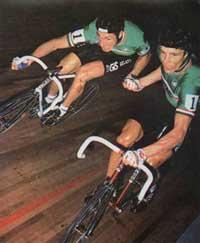
Once the ergonomic and aerodynamic bike is designed, there is a weight problem in which the type of material is closely related. Very varied materials have been tested but there is no total decision. Carbon fiber composites are becoming less and less used in racing due to the formation of too rigid frames and decreased performance by transmitting lateral forces to the wheels. If it also falls, these fiber plastics can break and cause wounds with sharp edges.
Titanium, at the same strength, is 45% lighter than steel, but has not yet spread. Price and welding problems. Aluminium alloys are currently the most used, although steel frames have also been made.
Track bikes
Running on the track means there are certain conditions. There is no wind, no holes in the ground and higher speeds can be achieved. Consequently, bicycles are also completely different. These are bikes without brakes or pinion changes and the profile is designed to make the cyclist go as fast as possible. Therefore, if the air resistance on the road bike is 200 watts to 50 km/h, on the track bike is only 35 watts.
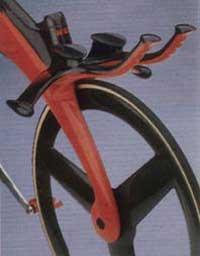
At the Barcelona Olympics, for example, Englishman Chris Boarman won the chase test with 4 kilometres of oval track at 54 km/h. Manufactured by Lotus, it had a bike with carbon fiber and glass cover and titanium armor and the front wheel fork of a single arm. In these cases the bike is for track and for a certain cyclist.
These science-like machines can be considered newborns. Although they appeared in 1985, they were banned by the International Cycling Society. Now, however, they are back in development and the track record is higher than 51 km/h.





